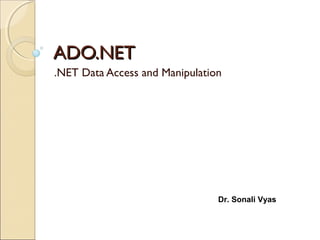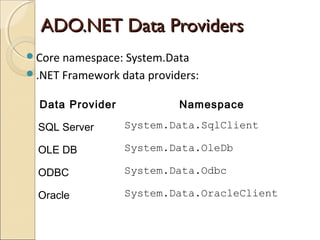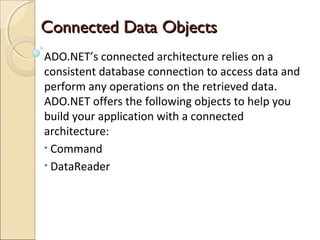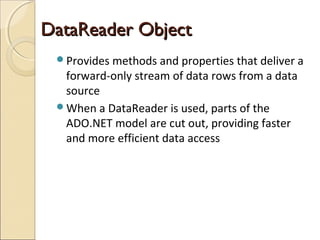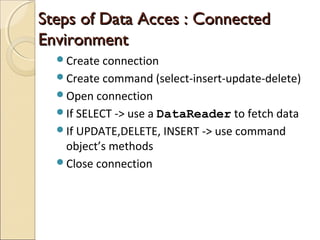ADO .Net
- 1. ADO.NETADO.NET .NET Data Access and Manipulation Dr. Sonali Vyas
- 2. OverviewOverview ïWhat is ADO.NET? ïADO.NET Architecture ïAdo.NET Data Providers ïADO.NET Core Objects ïDisconnected Data Objects ïConnected Data Objects ïUnderstanding .NET Data Providers
- 3. What is ADO.NET?What is ADO.NET? ïA data-access technology that enables applications to connect to data stores and manipulate data contained in them in various ways ïAn object oriented framework that allows you to interact with database systems
- 4. Objective of ADO.NETObjective of ADO.NET ïSupport disconnected data architecture, ïTight integration with XML, ïCommon data representation ïAbility to combine data from multiple and varied data sources ïOptimized facilities for interacting with a database
- 6. ADO.NETADO.NET Data ProvidersData Providers ïCore namespace: System.Data ï.NET Framework data providers: Data Provider Namespace SQL Server System.Data.SqlClient OLE DB System.Data.OleDb ODBC System.Data.Odbc Oracle System.Data.OracleClient
- 7. ADO.NET Core ObjectsADO.NET Core Objects Object Description Connection Establishes a connection to a specific data source. (Base class: DbConnection) Command Executes a command against a data source. Exposes Parameters and can execute within the scope of a Transaction from a Connection. (The base class: DbCommand) DataReader Reads a forward-only, read-only stream of data from a data source. (Base class: DbDataReader) DataAdapter Populates a DataSet and resolves updates with the data source. (Base class: DbDataAdapter) DataTable Has a collection of DataRows and DataColumns representing table data, used in disconnected model DataSet Represents a cache of data. Consists of a set of DataTables and relations among them
- 8. Connection objectConnection object ïConnects to databases. ïTwo provider-specific classes oSqlConnection oOleDbConnection. ïConnections can be opened in two ways: oExplicitly by calling the Open method on the connection oImplicitly when using a DataAdapter. ïConnections handle transactions
- 9. Connection (Cont.)Connection (Cont.) String connString = string.Empty; connString = âserver = sqlexpress; integrated security = trueâ; // Window Authentication //OR connString = âserver = sqlexpress; user id = sa; password = 1234567â; // SQL Authentication SqlConnection conn = new SqlConnection(connString); Conn.Open(); // // Code // Conn.Close();
- 10. ConnectedConnected DataData ObjectsObjects ADO.NETâs connected architecture relies on a consistent database connection to access data and perform any operations on the retrieved data. ADO.NET offers the following objects to help you build your application with a connected architecture: âĒ Command âĒ DataReader
- 11. Command ObjectCommand Object ï Information submitted to a database as a query via a Connection object ï Two provider-specific classes o SqlCommand o OleDbCommand ï Input and output parameters are supported, along with return values as part of the command syntax ï Results are returned in the form of streams. Accessed by: o DataReader object o DataSet object via a DataAdapter
- 12. Command (Cont.)Command (Cont.) Commands have several different methods for executing SQL. The differences between these methods depend on the results you expect from the SQL. Queries return rows of data (result sets), but the INSERT, UPDATE, and DELETE statements donât.
- 13. DataReader ObjectDataReader Object ïProvides methods and properties that deliver a forward-only stream of data rows from a data source ïWhen a DataReader is used, parts of the ADO.NET model are cut out, providing faster and more efficient data access
- 14. Connected Data Access ModelConnected Data Access Model
- 15. Steps of Data Acces : ConnectedSteps of Data Acces : Connected EnvironmentEnvironment ïCreate connection ïCreate command (select-insert-update-delete) ïOpen connection ïIf SELECT -> use a DataReader to fetch data ïIf UPDATE,DELETE, INSERT -> use command objectâs methods ïClose connection
- 16. Disconnected Data ObjectsDisconnected Data Objects ADO.NETâs disconnected architecture offers flexible application design and helps organizations save database connections. ADO.NET offers the following objects to help you build your application with a disconnected architecture: âĒDataAdapter âĒ DataSet
- 17. DataAdapter ObjectDataAdapter Object ïProvides a set of methods and properties to retrieve and save data between a DataSet and its source data store ïAllows the use of stored procedures ïConnects to the database to fill the DataSet and also update the database
- 18. DataSet ObjectDataSet Object ïReplaces the ADO Recordset ïRepresents a cache of data that contains tables, columns, relationships, and constraints, just like a database ïRegardless of where the source data comes from, data can all be placed into DataSet objects âĒ Tracks changes that are made to the data it holds before updating the source data ï DataTable ï DataColumn ï DataRow
- 20. Disconnected Data Access ModelDisconnected Data Access Model
- 21. Steps of Data Access: DisconnectedSteps of Data Access: Disconnected EnvironmentEnvironment ïDefining the connection string ïDefining the connection ïDefining the command ïDefining the data adapter ïCreating a new DataSet object ïSELECT -> fill the dataset object with the result of the query through the data adapter ïReading the records from the DataTables in the datasets using the DataRow and DataColumn objects ïUPDATE, INSERT or DELETE -> update the database through the data adapter
- 22. Pros and ConsPros and Cons Connected Disconnected Database Resources - + Network Traffic - + Memory Usage + - Data Access - +
- 23. Understanding .NET Data ProvidersUnderstanding .NET Data Providers
- 24. Commonly Used SqlClient ClassesCommonly Used SqlClient Classes
- 25. Commonly Used OleDb ClassesCommonly Used OleDb Classes
- 26. Commonly Used Odbc ClassesCommonly Used Odbc Classes
- 27. SummarySummary This presentation was about two main types of data access that are provided from ADO.NET; Connected Data Objects and Disconnected Data Objects. Both types have their own advantages to fulfill the full-functionality to access data. Both types have their own main components. âĒConnected Data Objects : Connection, Command, and DataReader. âĒDisconnected Data Objects : DataSet, DataAdapter, DataTable, DataColumn and DataRow.

